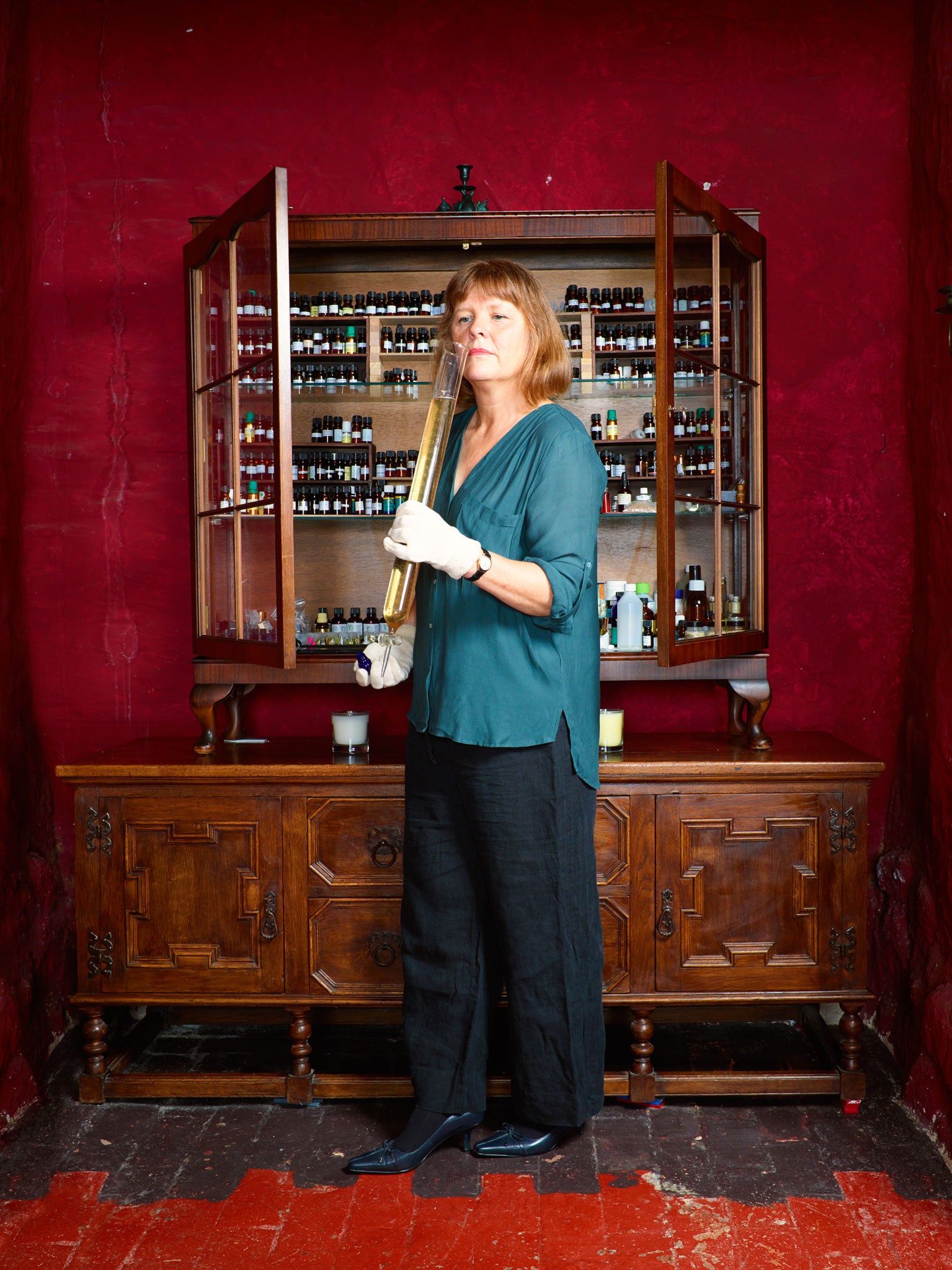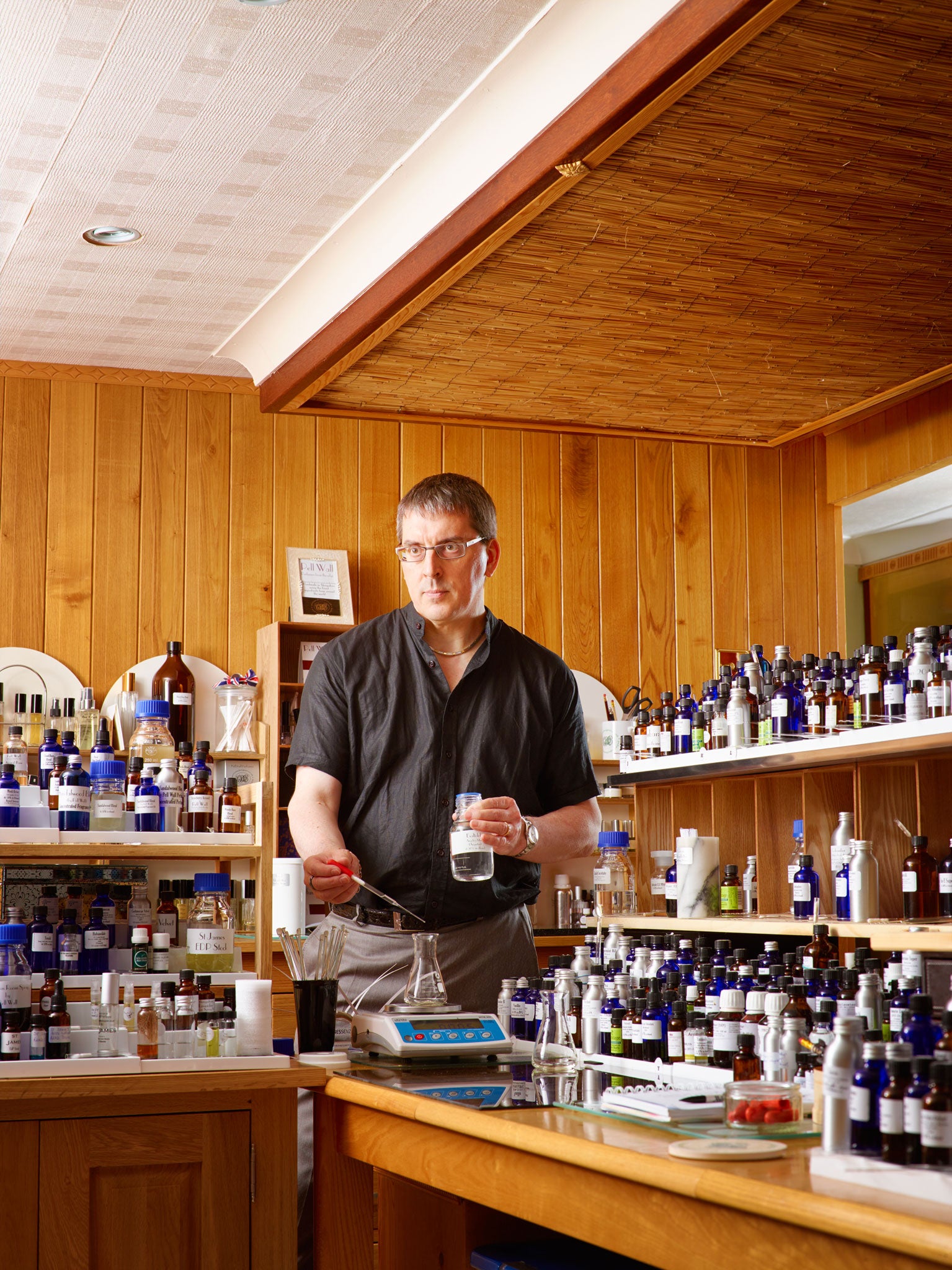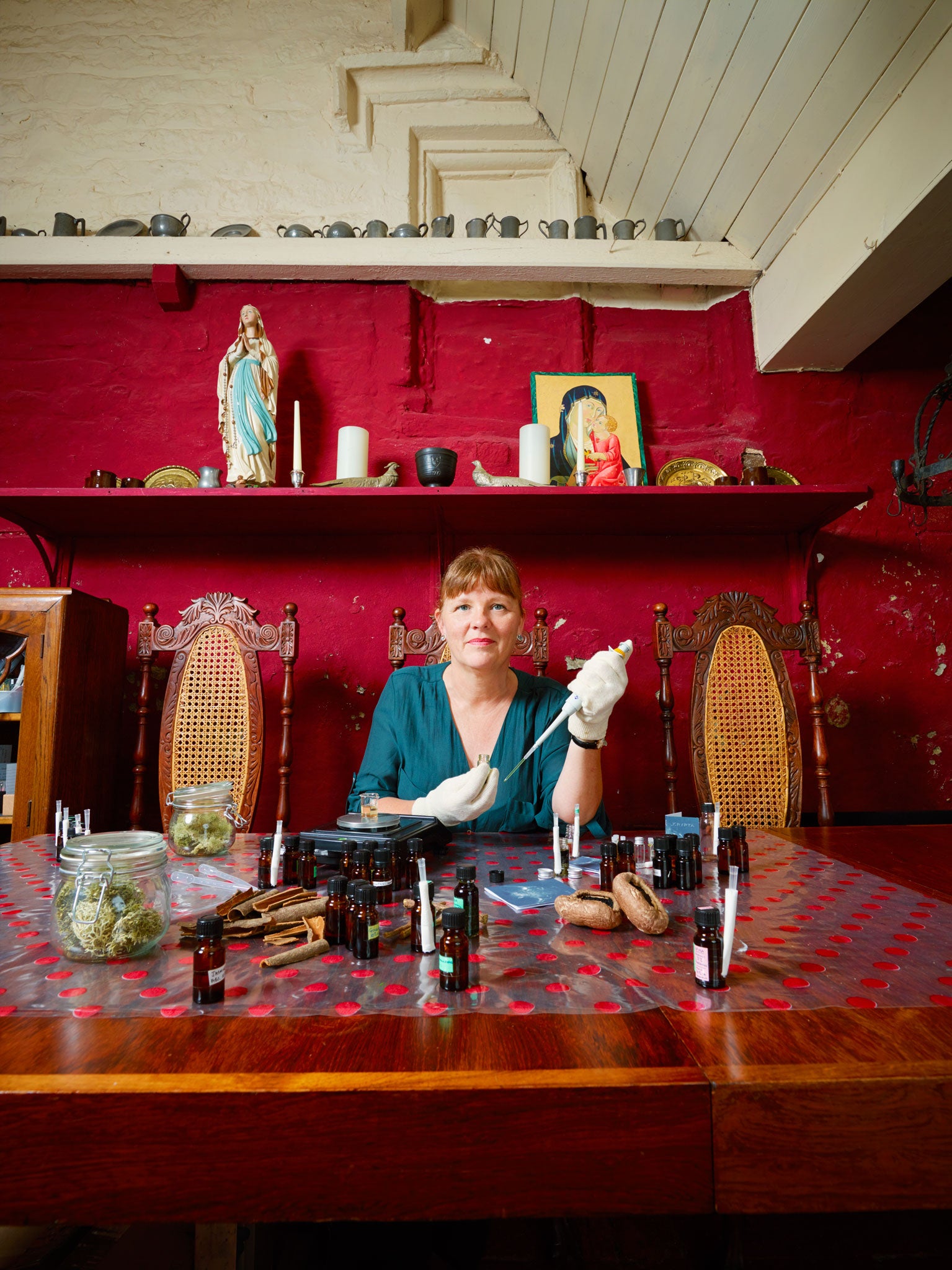Surreal life of the amateur perfumer: Hazmat couriers, guesswork and badger excrement
They grub around in forests for moss; they buy a kilo of tincture to use just 5ml; the authorities hold them in high suspicion; they prise open plastic bags to be hit by the heady scent of badger excrement. And all for what? To be able to create a fragrance whose ultimate ingredient is luck…

Your support helps us to tell the story
From reproductive rights to climate change to Big Tech, The Independent is on the ground when the story is developing. Whether it's investigating the financials of Elon Musk's pro-Trump PAC or producing our latest documentary, 'The A Word', which shines a light on the American women fighting for reproductive rights, we know how important it is to parse out the facts from the messaging.
At such a critical moment in US history, we need reporters on the ground. Your donation allows us to keep sending journalists to speak to both sides of the story.
The Independent is trusted by Americans across the entire political spectrum. And unlike many other quality news outlets, we choose not to lock Americans out of our reporting and analysis with paywalls. We believe quality journalism should be available to everyone, paid for by those who can afford it.
Your support makes all the difference.My friend Kev Hopper is laughing, stoically. "It's the worst start to a hobby I've ever had," he says, rummaging through the contents of a shoebox he just fetched from a drawer in his bedroom. It contains maybe three-dozen tiny bottles with neatly printed labels, some with reassuringly familiar terms ("Cherry") and others less so ("cis-3-Hexen-1-ol"). "Making perfume is like painting a picture, or cooking," he says. "It's about curiosity, having abstract ideas. Sometimes I think, 'What would peanuts and grass smell like, maybe with some burnt wood? They're three things I like, so why not combine them and see?' The trouble is that it's a nightmare to get hold of the things you need."
Kev holds up a vial of Galaxolide, a chemical with a musk-like aroma. "I had to get this from a Dutch website, putting everything through Google Translate to find out what I was ordering. It felt seedy."
The essential attributes of the amateur perfumer include huge reserves of tenacity, patience and bloody-minded perseverance. A desire to create fragrances will be thwarted at every turn by red tape, unavailable ingredients and an almost hilarious lack of information. Kev demonstrates this to me by knocking up a scent I might like, defined mainly by guesswork and chance. He drops tiny amounts of sandalwood, Hedione, bergamot and the aforementioned Galaxolide into a thimble of pure alcohol, and we sniff it. It's OK; hardly Creed's Green Irish Tweed, but it was never going to smell like Green Irish Tweed, not least because we have no idea what's in Green Irish Tweed. That kind of knowledge is accessible only to a tiny number of people working at the big perfume houses. Last year the biggest, Givaudan, had a record number of students at its perfumery school: five. Training lasts for years, with precious little opportunity for juniors to create fragrances; when that time does finally arrive, it might be for something as unglamorous as a toilet detergent.
Perfumers are bound by contract not to discuss their work, so industry gurus such as Jean-Claude Ellena – Givaudan's very first student back in 1968 – will skirt around the subject in interviews using guarded, abstract terms.
"Good perfumers are illusionists," says Pia Long, technical manager at Equinox Aromas, a British supplier to the cosmetics industry. "They can create an illusion of a very complex fragrance with a small number of unromantically named synthetics. If the public knew what was in the perfumes, it would destroy that magic."
But many amateurs have developed a profound hunger for that kind of knowledge. "I want what Jean-Claude Ellena has," says Fran Schofield, an amateur perfumer based near Oxford, "but I don't know how to get it. So I have to find out for myself."
In a dining room masquerading as a makeshift laboratory, Schofield carefully opens a sealed plastic bag containing the petrified excrement of the Cape Hyrax, or South African rock badger, and wafts it under my nose. It's powerful stuff. "For me, doing all this is an expression of art," she says. "It's completely fascinating creating smells from scratch. It's a bit like being a London taxi driver: in order to know your way around London, you've got to learn every single street." Around us are countless materials that have been "robbed from nature", as she puts it: Welsh tree moss tincturing in alcohol, osha root, several kinds of myrrh, a breakfast mushroom, bee propolis, fat imbued with a hint of lilac. You'll rarely find these kind of things in a professional perfumery; as ingredients they can be wildly inconsistent and often very expensive.
"The thing about an aroma chemical," says Schofield, "is that it's a single molecule. You can make that behave. But these things are made of hundreds of ingredients, so you have to be more selective about what you're using with what. Otherwise you just get mud."

Natural materials provide an enticing route into amateur perfumery, with nature's bounty freely available and a freedom to experiment that major-league perfumers simply do not have. "Yep, you can make lovely things out of stuff you find in the forest," says Sarah McCartney, founder of independent perfumery 4160 Tuesdays. "Only for yourself, though. If you want to run a perfumery, you can't use them. It's illegal."
The flaming hoops McCartney has had to jump through to progress from amateur to professional would make any normal person ossify with frustration. "To get your perfume into the shops you need a product safety assessment done by a qualified member of the Royal Society of Chemistry," she says. "That's EU law, and its ultimate aim seems to be to get rid of perfume altogether, that perfume is all vanity, and there's no excuse for risk when it comes to vanity."
Even selling via mail order is fraught with problems. The UN classes international perfume shipments as "dangerous goods" that must be packed in vermiculite and sent via Hazmat courier. "No one is going to pay me £200 to ship a few bottles to Japan," says McCartney. "Even within the UK with Royal Mail I can only post up to four bottles at a time – a silly, random number – and no more than 150ml each. It's doable, but sometimes I have to use two or three parcels when one would suffice."
Then there are the 175 International Fragrance Association (IFRA) restrictions governing the safe use of ingredients. "You should see the safety data for lavender oil," says Chris Bartlett, who runs an independent perfumery, Pell Wall Perfumes, in Shropshire. "You could have a bath in lavender oil – although don't do that – and you wouldn't come to harm. But if you read the safety information you'd think your body would dissolve. Geraniol has the same symbol on its bottle as caustic soda! In the quantities an amateur perfumer buys them in, they're harmless."
There are, however, very real safety considerations with perfume; for example, nitro-musks – the first artificial musks – were found to be carcinogenic, while the polycyclic musks that replaced them tended to be persistent in human tissue and the environment. Sensitisation and allergic reactions can and will happen, but finding out whether your perfume will cause such problems is a huge administrative headache. Bartlett, a studious and highly methodical man, chose to self-regulate, digesting and then summarising the IFRA rules for other perfumers to follow on his website.
McCartney, however, took a different route. "I spent £2,000 on regulatory software that assesses my products for compliance," she says. "I've offered to run other independent perfumers' formulae through the software, to help them, but of course they refuse because they want to keep their formulae secret."
Indeed, that professional veil of secrecy seems to have been inherited by the amateurs. While websites such as basenotes.com and fragrantica.com are active with thousands of people discussing fragrances' relative merits, offering outspoken opinions about, say, Le Labo's Oud 27 ("sour tangerine gone wrong, mixed with piss"), there's little help on offer for anyone who wants to get creative. "It's a field crying out for collaborative input," says Kev Hopper, "but people seem to work in secrecy."
Demystifying processes and providing information is something Chris Bartlett has dedicated himself to, in particular to give amateurs access to the aroma chemicals that have proved so elusive. "You might only need 5ml of something," he says, "but I'm prepared to buy it by the kilo. Although even then it's difficult. One supplier took six months to decide they'd sell anything to me, including a very long telephone interview to find out if I knew what I was doing."
Aroma chemicals are the mysterious building blocks of the high-street fragrance, and the nomenclature is confusing and impenetrable. The coconut note in a bottle of Escada is known as gamma-nonalactone. Nona-2-trans-6-cis-dienal is distinctly cucumbery. Geosmin gives you a whiff of petrichor, the smell of rain on dry earth. Fructalate is, as Bartlett describes it, "like a non-edible fruit – a plastic apple".

All these molecules can be identified in perfumes by expensive spectrometers, so the big perfume houses are able to work out exactly what's in each other's fragrances. But for the amateur, it's not so simple. It's about guesswork, learning, honing one's sense of smell and grappling with chemistry.
"If I use methyl anthranilate," says Bartlett, "which smells like a floral grape, with some Vanillin – a kind of chocolatey vanilla – you'll get a sweet floral scent. But over time it'll turn black. You probably wouldn't want that in a white candle. That's chemistry you just have to learn."
Even with that knowledge, there's still the difficulty of obtaining pure alcohol, the main ingredient in any fragrance and one subjected to strict UK laws designed to stop it being made into drinks. Amateur perfumers aren't that keen to go on the record and openly state where they get it from, but sources range from mysterious eBay sellers that appear and disappear randomly, to summer visits to supermarkets in Italy and trucks coming across the Irish Sea at night.
But still they persist, inspired by a curious mix of creative ambition and mathematical precision; the hippy meets the nerd. While pieces of ambergris – that incredibly rare and elusive waxy substance produced in a whale's gut – are being lovingly tinctured in an ornate jar on one side of the room, there's maths to be done on the other. "You might buy some material at 5 per cent strength," says McCartney, "you've mixed it up at 25 per cent, you have 60g at the moment, but need 4kg of product at 10 per cent dilution."
While calculations spin in their heads, perfumers will simultaneously struggle to describe their creations in meaningful terms, talking about "green" smells and "powdery" notes that you can only truly appreciate by getting your nose in there and inhaling.
Schofield shows me one of her painstakingly recorded index cards containing her assessments of her perfumes the day after they're made, and it's like a wonderful crossword clue: "Amber tar aeroplane fuel note too rubbery, maybe." Maybe. Who knows? It's evidently a ferociously engrossing hobby.
Perfume is fascinating anyway, that ability it gives you to carry an indescribable aura with you as you socialise. But even when you become familiar with the manufacturing processes and some of the 4,000 ingredients used in fragrances, perfume is still an eternal mystery.
"I'm trying to get rid of some of the smokescreen bollocks that has pervaded in this world," says McCartney – but while her courses in perfumery may educate you a little, they'll also suck you into a world where you endlessly pursue the scent of beauty, the scent of carnal sex, by using small drops from dozens of tiny bottles.
Amateur perfumers seem to share one trait in particular to which they were all happy to admit, and Schofield perhaps put it best. "What else can I possibly tell you," she says, "other than the fact that I'm an absolute lunatic?"
Join our commenting forum
Join thought-provoking conversations, follow other Independent readers and see their replies
Comments